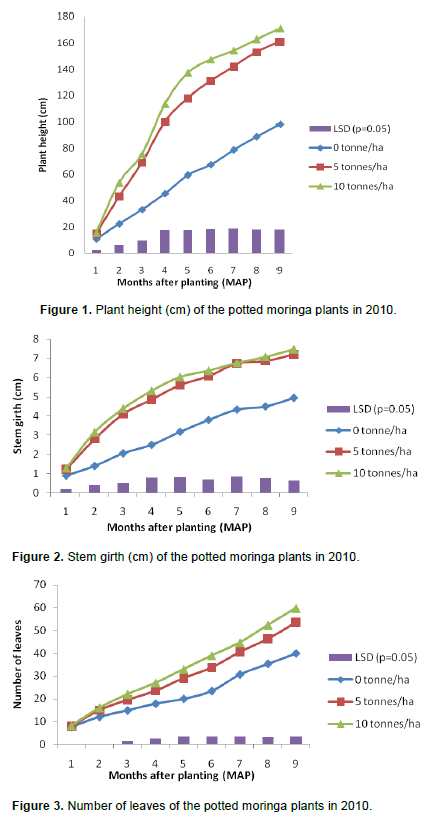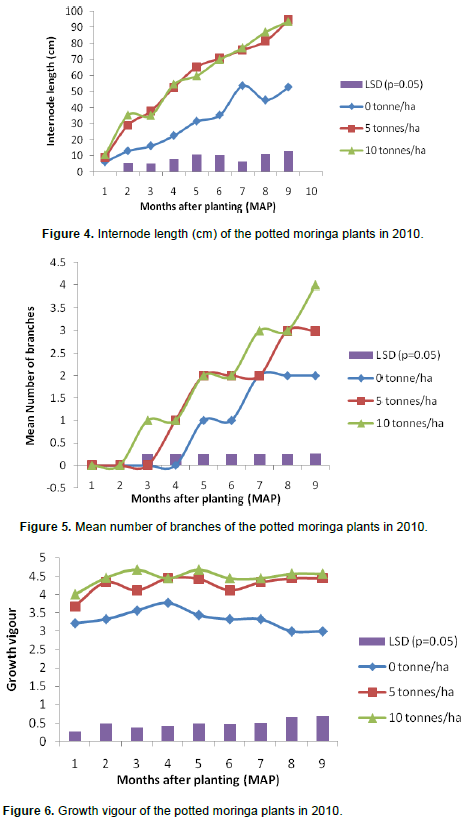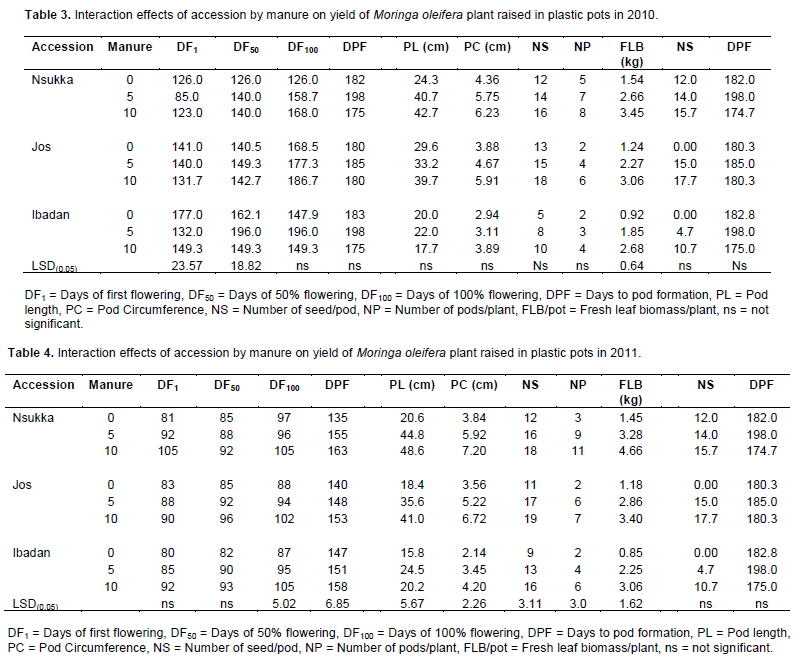ABSTRACT
The study was carried out in the University of Nigeria, Nsukka, Nigeria from 2010 to 2011 to assess the effect of poultry manure application on growth and performance of potted moringa (Moringa oleifera Lam) plants raised for urban dwellers’ use. Application of five and 10 tonnes/ha of poultry manure to the soil medium ensured consistent increase in the plant height, stem girth, internode length, number of leaves and branches. The control treatment (0 tonne/ha) had the least values of all the morphological characteristics. The 10 tonnes/ha poultry manure treatment gave significant increase (p < 0.05) in the plant growth vigour in the first two months of growth with a decrease in the third month. The interaction effects of accession by poultry manure were significant (p < 0.05) on the days to initial flowering, days to 50% flowering and fresh leaf biomass production/plant but not significant (p > 0.05) on the days to 100% flowering, days to pod formation, number of pods/plant, number of seeds/pod, pod length and pod circumference. The 10 tonnes/ha poultry manure gave the highest values of all the yield traits in 2011 followed by five tonnes/ha and zero tonne/ha respectively. There were significant accession by manure interaction effects (p < 0.05) on all the yield traits except days to first and 50% flowering. There were lesser days to first, 50%, 100% flowering and pod formation and higher values of all the other yield traits in 2011 than in 2010.
Key words: Nigeria, potted Moringa plants, poultry manure, urban dwellers.
Moringa oleifera is a small deciduous, fast growing and drought resistant plant. It is also a perennial tree which can reach a maximum height of 7-12 m and a diameter of 20-40 cm at chest height. The stem is normally straight and branches at a height of 1.5 to 3 m (Fuglie and Sreeja, 2011) . It grows best in loamy or sandy loam soil and can tolerate poor but not water-logged soils. M. oleifera is a highly nutritious and medicinal plant with great agricultural, industrial and domestic uses (Moyo et al., 2011, Ndubuaku and Ndubuaku, 2011).
Cultivation of moringa plants in the urban cities has not been adequately exploited in Nigeria because of land limitations. This problem can sufficiently be resolved by raising moringa plants in pots like plastic buckets, earthenware pots, baskets etc. The nutrient status of the potting medium (soil) in the container should be relatively high to support the life of the plant for a long period and can be augmented periodically with split doses of poultry manure and NPK (Nitrogen:Phosphorus:Potassium) fertilizer (Annenber, 2010). Ede et al. (2015) worked on integrated nutrient management in moringa production and observed that weathered sawdust plus poultry manure medium gave the highest mean coefficient velocity of seedling emergence followed by 100% sawdust medium.
The leaves of the potted moringa plants can be harvested periodically for use as the plant re-flushes fast , and pinching the terminal bud on the central leader stem is found to be necessary when it attains a height of 75 cm to
promote the growth of many lateral branches and reduce the height of the tree (Amaglo, 2010). Potted moringa plants can be kept as outdoor plants and watered routinely especially during the dry season. Moringa trees can also be planted as hedge-row plants around houses, parks, schools, hospitals etc. Moringa plants respond well to irrigation and the yield can be doubled by drip irrigation as compared to rain fed crops (Oz, 2014).
Fifty-four 30 L capacity black plastic buckets perforated at the base were used to raise the moringa plants in an un-shaded nursery in the Department of Crop Science, Faculty of Agriculture, University of Nigeria, Nsukka, Nigeria.
Each bucket contained 25 kg of soil. Cured poultry manure was incorporated into the soil in the buckets at the rates of 0 tonne /ha, 5 tonnes /ha and 10 tonnes/ha, respectively before sowing the seeds. Three seeds were planted in each bucket. Two litres of water was added to each bucket of soil before planting and subsequently at three days intervals during the early periods of growth (between April and late May, 2010 when there was less rainfall). The water was just enough to sustain the growing seedlings in the buckets without leakage from the perforations below. However, the plants were rain-fed between June and November, 2010 (during regular rains). Controlled watering was continued from December, 2010 to May, 2011 before regular rains commenced again. The moringa seeds used for the experiment were collected from three locations in Nigeria namely; Nsukka (in the southeast), Ibadan (in the west) and Jos (in the north). The experimental design was a 3 × 3 factorial in completely randomized design with three replications. Morphological growth and yield attributes of the plants were monitored for two years; 2010 and 2011. Sowing of the seeds was done in April, 2010 and the records of the morphological growth and yields were taken till December, 2010 for the first phase of growth. The subsequent yield records were taken till September, 2011.
The morphological characteristics measured included the stem height (cm), stem girth (cm), number of leaves, number of branches, internode length and plant growth vigour. The parameters were recorded monthly. The root volume was determined at the ninth month of the study to avoid frequent destructive sampling.
Plant height was measured from the base of the plant to the tip of the terminal leaf bud with a meter rule. Stem diameter was measured five centimeters above ground level using micrometer screw gauge and converted to girth using the following formula:
G = Dπ
Where G is the stem girth, D is the stem diameter and π is a constant (π = 22/7).
The number of leaves and branches were determined by counting. The number of leaves /plant was determined by the number of nodes on the plant to include the abscised leaves. The internode length was measured with a meter rule between two adjacent nodes. The root volume was determined by immersing the root system into a calibrated cylinder with a known volume of water and recording the displacement (d). The formula is as follows:
Root Volume (RV) = Final water volume (FWV) – Initial water volume (IWV) = Displacement (d)
Thus, RV = FWV – IWV = d.
The plant growth vigour was determined by using the assessment indices for the growth of M. oleifera plant as shown in Table 1. The yield attributes measured included days to flowering which was recorded as the number of days from sowing to first flower production; days to 50 and 100% flowering recorded as the number of days from sowing to when 50 and 100% of the plants flowered, days to pod formation and setting, number of pods/plant, number of seeds per pod, pod length (cm) and pod circumference (cm). After the 2010’s yield, the apical shoot was pruned from a height of 50 cm above the ground and all the leaves harvested (apart from the abscised leaves) to determine the fresh leaf biomass and prepare for 2011 yield.

Statistical data collected were analyzed using analysis of variance (ANOVA). Significant means were compared using Fisher’s least significant difference (FLSD) at 5% probability according to Obi (2002). The statistical package used was Genstat 3.0 release 4.23 Discovery Edition (2008).
Application of five and 10 tonnes/ha of poultry manure to the soil medium ensured consistent increase in the plant height, stem girth, internode length, number of leaves and branches. The control treatment (0 tonne/ha) had the least values of all the morphological characteristics (Figures 1 to 6). The poultry manure levels showed significant differences (p < 0.05) in the plant height and stem girth all through the growth period (Figures 1 and 2), and in internode length at the second month (Figure 4), number of leaves and branches at the third month (Figures 3 and 5). The internode lenghts of the moringa accessions showed a decrease on the seventh month of planting and started inproving from the eighth month. The 10 tonnes/ha poultry manure treatment gave significant increase (p < 0.05) in the plant growth vigour in the first two months of growth with a decrease in the third month. The plants treated with five tonnes/ha poultry manure grew vigorously within the first three months after planting and decreased in their growth vigour on the fourh and sixth months. The control plants decreased consistently in their growth vigour from the fourth month after planting. However, there were significant differences (p < 0.05) in the effects of the poultry manure levels on plant growth vigour which reflected all through the growth period in 2010 (Figure 6). The 10 tonnes/ha poultry manure gave the highest values of the plant height, stem girth, plant growth vigour, number of leaves and branches at the ninth month of the plants growth in 2010. The internode length values obtained in the five and 10 tonnes/ha manure treatments were statistically similar at the ninth month. Figures 1 to 6 show the average values of the morphological parameters of the three moringa accessions as influenced by the different rates of poultry manure.


There were no significant accession differences (p > 0.05) in the morphological traits at the ninth month of the plants growth in 2010 (Table 2). Table 3 shows the interaction effects of accessions and poultry manure levels on yield traits in 2010. There were significant differences (p < 0.05) in the days to initial, 50% flowering and fresh leaf biomass production/plant and none in thedays to 100% flowering, days to pod formation, number of pods/plant, number of seeds/pod, pod length and pod circumference. The five tonnes/ha poultry manure gave the least number of days to initial flowering in Nsukka and Ibadan accessions while the control (0 tonne/ha) gave the least number of days to 50% flowering in Nsukka and Jos accessions and to 100% flowering in all accessions. The Nsukka accession gave the highest leaf biomass production followed by Jos and Ibadan accessions respectively. The 10 tonnes/ha gave the least number of days to pod formation and the highest values of the number of pods/plant, number of seeds/pod, fresh leaf biomass, pod length and circumference. Table 4 shows the interaction effects of accessions by poultry manure on the yield traits in 2011. The 10 tonnes/ha poultry manure gave the highest number of days to first, 50% and 100% flowering as well as all the yield traits in 2011 followed by five tonnes/ha and zero tonne/ha respectively. The Nsukka accession flowered most promptly and thus, had the least number of days to initial flowering (85 days). There were significant accession by manure interaction effects (p < 0.05) on all the yield traits except days to first and 50% flowering. There were lesser days to first, 50%, 100% flowering and pod formation but higher values of all the other yield traits in 2011 than in 2010 as shown in Tables 3 and 4.


No records of the morphological growth characteristics were taken in 2011, because of the pruning of the shoot in December, 2010, to avoid inconsistencies in the results. Subsequent study will show the growth pattern of the plants from 2012 to date.
The higher values of the morphological and yield traits obtained with poultry manure application was a good indication that moringa plants could respond positively to manure application. Ndubuaku et al. (2014) observed that poultry manure increased the nutrient status of the soil and boost crop productivity. According to Ojeniyi et al. (2012), application of liquid agro-industrial by-products increased soil-plant nutrient supply by releasing structurally bound elements such as N, P and Ca in soil solution during decomposition thereby increasing crop growth and yield. Ede et al. (2015) integrated nutrient management encompassing poultry manure and other organic media in moringa production and obtained a positive response of moringa to the application of poultry manure. Topsoil and poultry manure mixtures can, therefore, constitute a suitable medium for potting moringa plants for urban dwellers’ use. There was faster flowering and pod setting in 2011 than 2010 probably due to age of the plants. There was delayed pod setting in the plants raised in the poultry manure media in 2011. This could be due to competitive effects of vegetative growth which could have delayed the onset of reproductive growth such as flowering and pod formation in the poultry manure media. The 10 tonnes/ha poultry manure application gave the greatest values of both morphological and pod yield. However, the optimum level should be ascertained in subsequent trials.
The urban dwellers can, therefore, be afforded the privilege of growing moringa in plastic buckets or any other suitable containers with a mixture of topsoil and poultry manure. The nutrient status of the planting medium can be upgraded periodically with split doses of poultry manure and NPK fertilizer. The leaves can be harvested periodically for use as pruning of leaves in this study increased leaf biomass production and pod yield.
There is no conflict of interest among the authors.
The authors acknowledge and appreciate the effort of the Head of Department of Crop Science, Faculty of Agriculture, University of Nigeria, Nsukka for giving them the privilege to carry out the experiment in the departmental nursery.
REFERENCES
|
Amaglo NK (2010). Growing and processing moringa leaves. |
|
|
|
Annenber F (2010). How to plant and grow moringa. |
|
|
|
Ede EA, Ndubuaku UM, Baiyeri KP (2015). Media effects on emergenceand growth of moringa (Moringa oleifera Lam) seedlings grown n in the nursery. Am. J. Exp. Agric. (Sci. Domain J.), UK, USA, 7(3):182-189. |
|
|
|
Fuglie LJ, Sreeja KV (2011). Cultivation of moringa. |
|
|
|
Genstat (2008). Genstat 3.0 release 4.23 Discovery Edition, Lawes Agricultural Trust, Rothmanisted Experimental Station, UK. |
|
|
|
Moyo B, Masika PJ, Hugo A, Muchenje V (2011). Nutritional characterization of Moringa (Moringa Oleifera Lam) leaves. Afr. J. Biotechnol. 10:12925-12933. |
|
|
|
Ndubuaku TCN, Ndubuaku UM (2011). Moringa oleifera: Medicinal and nutritional crop. Its botany, production and utilization. University of Nigeria, Nsukka Press. |
|
|
|
Ndubuaku UM, Nwankwo VU, Baiyeri KP (2014). Influence of poultry manure application on the leaf amino acid profile, growth and yield of moringa (Moringa oleifera Lam). Albanian J. Agric. Sci. Albania 13(1):42-47. |
|
|
|
Obi IU (2002). Statistical methods of detecting differences between treatment means for field and laboratory experiments. AP Publishers Co. Nig. Ltd. |
|
|
|
Ojeniyi SO, Akami DJ, Odedina SA (2012). Use of agricultural waste for improving soil crop nutrients and growth of cocoa seedlings. Niger. J. Soil Sci. 22(1):190-195. |
|
|
|
Oz D (2014). Moringa news, articles and information: Moringa: A miracle tree being promoted as a solution to third world malnutrition. |